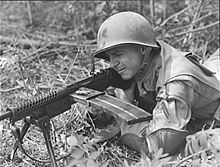
A semi-automatic rifle is an autoloading rifle that fires a single cartridge with each pull of the trigger and uses part of the fired cartridge's energy to eject the case and load another cartridge into the chamber. In contrast, a bolt-action rifle requires the user to cycle the bolt manually before they can fire a second time, and a fully automatic rifle fires continuously until the trigger is released.
A semi-automatic firearm, also called a self-loading or autoloading firearm, is a repeating firearm whose action mechanism automatically loads a following round of cartridge into the chamber and prepares it for subsequent firing, but requires the shooter to manually actuate the trigger in order to discharge each shot. Typically, this involves the weapon's action utilizing the excess energy released during the preceding shot to unlock and move the bolt, extracting and ejecting the spent cartridge case from the chamber, re-cocking the firing mechanism, and loading a new cartridge into the firing chamber, all without input from the user. To fire again, however, the user must actively release the trigger, allow it to "reset", before pulling the trigger again to fire off the next round. As a result, each trigger pull only discharges a single round from a semi-automatic weapon, as opposed to a fully automatic weapon, which will shoot continuously as long as the ammunition is replete and the trigger is kept depressed.
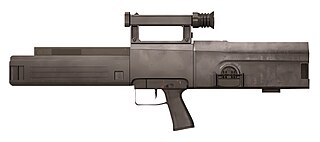
The Heckler & Koch G11 is a non-production prototype assault rifle developed from the late 1960s–1980s by Gesellschaft für Hülsenlose Gewehrsysteme (GSHG), a conglomeration of companies headed by firearm manufacturer Heckler & Koch, Dynamit Nobel, and Hensoldt Wetzlar. The rifle is noted for its use of caseless ammunition.

A magazine, often simply called a mag, is an ammunition storage and feeding device for a repeating firearm, either integral within the gun or externally attached. The magazine functions by holding several cartridges within itself and sequentially pushing each one into a position where it may be readily loaded into the barrel chamber by the firearm's moving action. The detachable magazine is sometimes colloquially referred to as a "clip", although this is technically inaccurate since a clip is actually an accessory device used to help load ammunition into a magazine or cylinder.

The ArmaLite AR-15 is a select-fire, gas-operated, air-cooled, magazine-fed rifle manufactured in the United States between 1959 and 1964. Designed by American gun manufacturer ArmaLite in 1956, it was based on its AR-10 rifle. The ArmaLite AR-15 was designed to be a lightweight rifle and to fire a new high-velocity, lightweight, small-caliber cartridge to allow infantrymen to carry more ammunition.

The ArmaLite AR-10 is a 7.62×51mm NATO battle rifle designed by Eugene Stoner in the late 1950s and manufactured by ArmaLite. When first introduced in 1956, the AR-10 used an innovative combination of a straight-line barrel/stock design with phenolic composite, a new patent-filed gas-operated bolt and carrier system and forged alloy parts resulting in a small arm significantly easier to control in automatic fire and over 1 lb (0.45 kg) lighter than other infantry rifles of the day. Over its production life, the original AR-10 was built in relatively small numbers, with fewer than 10,000 rifles assembled. However, the ArmaLite AR-10 would become the progenitor for a wide range of firearms.
The ArmaLite AR-18 is a gas-operated assault rifle chambered for 5.56×45mm NATO ammunition. The AR-18 was designed at ArmaLite in California by Arthur Miller, Eugene Stoner, George Sullivan, and Charles Dorchester in 1963 as an alternative to the Colt AR-15 design, a variant of which had just been selected by the U.S. military as the M16. A semi-automatic version known as the AR-180 was later produced for the civilian market. While the AR-18 was never adopted as the standard service rifle of any nation, its production license was sold to companies in Japan and the United Kingdom, and it is said to have influenced many later weapons such as the British SA80, the Singaporean SAR-80 and SR-88, the Belgian FN F2000, the Japanese Howa Type 89 and the German Heckler and Koch G36.
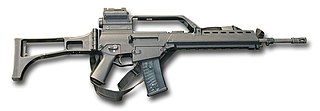
A semi or full-automatic firearm which is said to fire from a closed bolt is one where, when ready to fire, a round is in the chamber and the bolt and working parts are forward. When the trigger is pulled, the firing pin or striker fires the round; the action is cycled by the energy of the shot, sending the bolt to the rear, which extracts and ejects the empty cartridge case; and the bolt goes forward, feeding a fresh round from the magazine into the chamber, ready for the next shot.

The Stoner 63 is a 5.56×45mm NATO modular weapon system. Using a variety of modular components, it can be configured as an assault rifle, carbine, top-fed light machine gun, belt-fed squad automatic weapon, or as a vehicle mounted weapon. Also known as the M63, XM22, XM23, XM207 or the Mk 23 Mod 0 machine gun, it was designed by Eugene Stoner in the early 1960s. Cadillac Gage was the primary manufacturer of the Stoner 63 during its history. The Stoner 63 saw very limited combat use by United States forces during the Vietnam War. A few were also sold to law enforcement agencies.

Eugene Morrison Stoner was an American machinist and firearms designer who is most associated with the development of the ArmaLite AR-15 rifle that was redesigned and modified by Colt's Patent Firearm Company for the United States military as the M16 rifle.
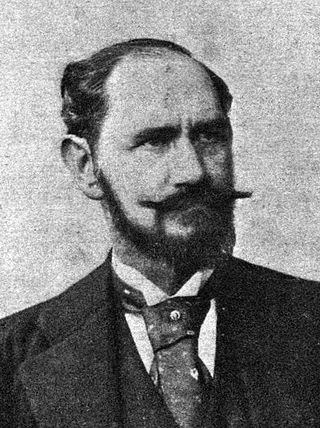
Ferdinand Ritter von Mannlicher was an Austrian engineer and small arms designer. Along with James Paris Lee, Mannlicher was particularly noted for inventing the en-bloc clip charger-loading box magazine system. Later, while making improvements to other inventors' prototype designs for rotary-feed magazines, Mannlicher, together with his protégé Otto Schönauer, patented a perfected rotary magazine design, the Mannlicher–Schönauer rifle, which was a commercial and military success.
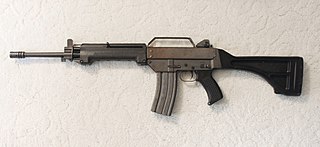
The Leader T2 MK5 Series firearms were chambered for the 5.56×45mm NATO cartridge and manufactured by Leader Dynamics of Smithfield, NSW, Australia (1978-1982/1983). The Leader was the brainchild of British weapons designer Charles St. George. It was originally a contender for a 5.56 mm Australian military service rifle to replace the then-issued Lithgow L1A1-F1 SLR and Colt M16A1 rifles. What was unique about this endeavor was that Australia had never designed or manufactured its own commercial gas-operated semi-automatic rifle. The rifle was abandoned when the Steyr AUG was adopted for use by the Australian military.
The Colt Automatic Rifle or Colt Light Machine Gun is a 5.56 mm NATO, open-bolt, full-automatic-only firearm developed by Colt Defense. It is based on the M16A2/A4, and has a distinctive squared-off handguard, vertical grip, carrying handle and integrated bipod.
The M1941 Johnson Rifle is an American short-recoil operated semi-automatic rifle designed by Melvin Johnson prior to World War II. Although the M1941 was used in limited numbers by the US Marines during the Second World War, it unsuccessfully competed with the contemporary M1 Garand rifle.
Melvin Maynard Johnson Jr., nicknamed Maynard Johnson, was an American designer of firearms, lawyer, and United States Marine Corps officer.

The LSAT light machine gun is a component of the Lightweight Small Arms Technologies (LSAT) program. The purpose of the program was to develop a lighter, yet highly reliable light machine gun (LMG). The program was initiated in 2004, when the Joint Service Small Arms Program (JSSAP) challenged the American defence industry to develop a lighter small arms and also design lighter ammunition.
ArmaLite, or Armalite, is an American small arms engineering company, formed in the early 1950s, in Hollywood, California. Many of its products, as conceived by chief designer Eugene Stoner, relied on unique foam-filled fiberglass butt/stock furniture, and a composite barrel using a steel liner inside an aluminum sleeve, including the iconic AR-15/M16 family. While the original ArmaLite ceased business in the 1980s, the brand was revived in 1996, by Mark Westrom.
Recoil operation is an operating mechanism used to implement locked-breech autoloading firearms. Recoil operated firearms use the energy of recoil to cycle the action, as opposed to gas operation or blowback operation using the pressure of the propellant gas.

The Next Generation Squad Weapon (NGSW) program is a United States military program created in 2017 by the U.S. Army to replace the 5.56mm M4 carbine, the M249 SAW light machine gun, and the 7.62mm M240 machine gun, with a common system of 6.8mm cartridges and to develop small arms fire-control systems for the new weapons.

